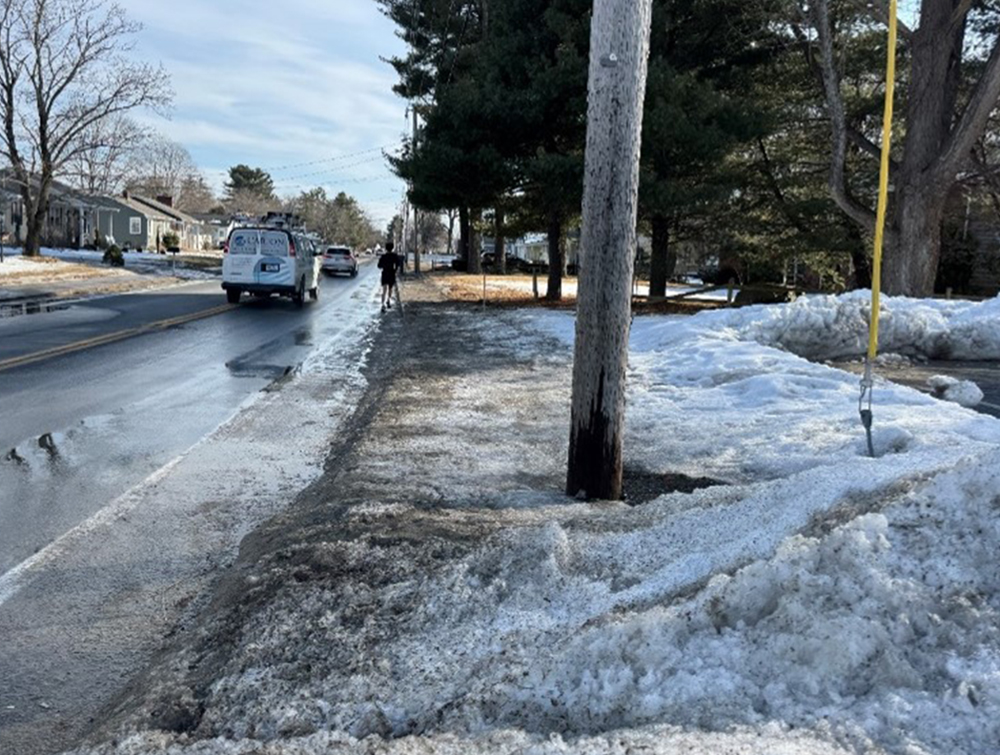
Shel Silverstein’s beloved poem Where the Sidewalk Ends invites us to imagine stepping beyond the pavement into a safer, more welcoming world, a place where imagination thrives, and dangers fade away. Yet in Smithfield, R.I., like in many modern towns, sidewalks often lead us not to safety but directly into harm’s way.
Recent crashes on Smithfield’s Pleasant View Ave. are tragic reminders that our streets are failing to protect us. These incidents highlight how road design can influence safety outcomes and that they are the result of decisions made – and not made – about how our streets are built and maintained. The good news is that change is possible.
Consider Pleasant View Ave., a road threading through the heart of Smithfield, connecting neighborhoods, schools, and businesses. Its current design sends a clear message: it’s built for cars, not people. Narrow sidewalks are obstructed by poles and signs, forcing pedestrians into precarious positions, and the absence of bike lanes leaves nowhere safe to ride. Children who should be able to walk or bike to school are left with few options but to navigate dangerous conditions or avoid the journey entirely.
These concerns are not theoretical. In July 2024, a bicyclist was fatally struck by a southbound tractor-trailer after falling from her bike on Pleasant View Ave. Just two months later, a driver, later charged with DUI, struck a cyclist, leaving them critically injured. These are not isolated incidents. A study of Smithfield roads found that Pleasant View Ave. had 47 total crashes in a recent study period, ranking it among the town’s most crash-prone roads.
This issue extends beyond a single street; it reflects how safety is prioritized throughout town. When road designs favor high vehicle speeds over the well-being of those walking and biking, we set the stage for preventable tragedies. Our streets should protect the most vulnerable among us. For example, Pleasant View Ave. still lacks continuous sidewalks in some areas, leaving pedestrians – especially those with mobility impairments – without a safe route.
Progress has been made in some areas. In 2016, Smithfield secured over $1 million in state and federal funding to improve sidewalks and pedestrian infrastructure on Pleasant View Ave. near the schools. These investments have walking safer for students, but they do not extend along the full corridor. In many places, pedestrians still must walk on the shoulder, as no sidewalks exist.

(photo courtesy Greg Guertin/Weston & Sampson)
Speeding is also a well-documented issue on Pleasant View Ave. The Rhode Island State Traffic Commission recently reviewed a request to lower the speed limit on Rte. 116, which includes Pleasant View, due to safety concerns. This aligns with what residents have observed; drivers traveling too fast in areas where people walk, bike, and access schools and businesses.
Just as the end of the sidewalk in Silverstein’s poem symbolizes a transition to a more imaginative and vibrant place, Pleasant View Ave. and others like it should safely lead us to the places we love throughout town. Instead, it highlights the shortcomings of our current approach. A main road in our town should be safe for everyone, yet these crashes remind us that for too many, it is not.
Safer streets don’t just protect lives; they also benefit local businesses and property values. Small towns that have prioritized pedestrian and cyclist safety have seen stronger commercial activity.
Littleton, N.H. provides a compelling example. Facing competition from big-box stores outside town, Littleton invested in wider sidewalks, pedestrian-friendly crossings, and a riverwalk bridge to encourage foot traffic downtown. As a result, storefront vacancies declined, local businesses saw increased sales, and the town was recognized nationally for their Main St. revitalization. This is just one of many examples showing that when you design streets to prioritize safety and accessibility, they can then become stronger economic assets.
Walkable communities also help retain employers and attract talent. Companies increasingly seek locations with vibrant, pedestrian-friendly downtowns because employees prefer safe, accessible places to work and live. When towns invest in safer streets, they are also investing in stronger economic development – a priority that benefits businesses, property owners, and residents alike.
So, what can we do? It begins with reimagining how we build our streets. By redesigning roads to naturally calm traffic, especially near schools and local businesses, we can create an environment where safety is the norm, not the exception. Proven strategies, such as extending sidewalks, adding bike lanes where feasible, and implementing pedestrian-friendly traffic signals – can make our streets safer while also supporting local commerce. Other communities facing similar challenges have successfully implemented safety improvements – Smithfield can do the same.
Cost will always be a concern, but the price of inaction is far greater. Every crash, every injury, and every life lost inflicts immeasurable pain on families within our community. Studies show that pedestrian and bicycle crashes result in millions of dollars in medical costs, lost productivity, and emergency response expenses. Investing in safety measures can reduce these long-term costs.
Silverstein’s poem encourages us to imagine what lies beyond the sidewalk’s end. Let’s ensure that beyond our sidewalks lies a safe, vibrant space where people can walk, bike, and connect without fear.
Greg Guertin is a project planner at Weston & Sampson, Foxboro, Mass.
 (1).png)







